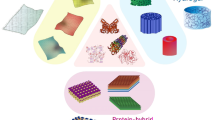Abstract
In the present work, bone-like nanocomposites have been successfully synthesized based on the mineralization of self-assembled protein-based microgels. Such mircogels were achieved by the in vitro reconstitution of collagen monomeric solutions in the presence of alginate in a microemulsion system. Microstructural observations revealed that the collagen-alginate composite beads possessed a nanofibrous three dimensional (3D) interconnected porous microstructure. The obtained microgels were pre-incubated in calcium-containing solution to capture Ca2+ ions, and subsequently immersed in phosphate-containing solution to initiate the formation of hydroxyapatite (HA) by an alternative incubating procedure. It was observed that a substantial amount of bone-like apatite nanocrystals were orderly and homogeneously deposited throughout the porous fibrillar networks. Herein, the collagen-alginate composite microgels served as a mineralization template for the synthesis of HA-polymer nanocomposites, which could be ideal vehicles potentially for cell carriers, bone repair and proteins and drugs delivery in tissue regeneration.








Similar content being viewed by others
References
Li JJ, Chen YP, Yin YJ, Yao FL, Yao KD. Modulation of nano-hydroxyapatite size via formation on chitosan-gelatin network film in situ. Biomaterials. 2008;28:781–90.
Ribeiro CC, Barrias CC, Barbosa MA. Calcium phosphate-alginate microspheres as enzyme delivery matrices. Biomaterials. 2004;24:4363–73.
Schachschal S, Pich A, Adler HJ. Aqueous microgels for the growth of hydroxyapatite nanocrystals. Langmuir. 2008;24:5129–34.
Zhao KY, Cheng GX, Huang JJ, Ying XG. Rebinding and recognition properties of protein-macromolecularly imprinted calcium phosphate/alginate hybrid polymer microspheres. React Func Polym. 2008;68:732–41.
Jongpaiboonkit L, Franklin-Ford T, Murphy WL. Mineral-coated polymer microspheres for controlled protein binding and release. Adv Mater. 2009;21:1–4.
Zhang J, Wang Q, Wang A. In situ generation of sodium alginate/hydroxyapatite nanocomposite beads as drug-controlled release matrices. Acta Biomateria. 2010;6:445–54.
Góes JC, Figueiró SD, Oliveira AM, Macedo AAM, Silva CC, Ricardo NMPS, Sombra ASB. Apatite coating on anionic and native collagen films by an alternate process. Acta Biomateria. 2007;3:773–8.
Kawashita M, Nakao M, Minoda M, Kim HM, Beppu T, Miyamoto T, et al. Apatite-forming ability of carboxyl group-containing polymer gels in a simulated body fluid. Biomaterials. 2003;24:2477–84.
Miyazaki T, ohtsuki C, Akioka Y, Tanihara M, Nakao J, Sakaguchi Y, et al. Apatite deposition on polyamide films containing carboxyl group in a biomimetic solution. J Mater Sci Mater Med. 2003;14:569–74.
Jen T, Huang HH, Lan CW, Lin CH, Hsu FY, Wang YJ. Studies on the microspheres comprised of reconstituted collagen and hydroxyapatite. Biomaterials. 2004;25:651–8.
Wang XM, Wang XL, Ma JF, Zheng GQ, Chen ZH, Li XD. Versatile nanostructured processing strategy for bone grafting nanocomposites based on collagen fibrillogenesis. Adv Appl Ceram. 2009;108:384–8.
Li X, Chang J. Preparation of bone-like apatite-collagen nanocomposites by a biomimetic process with phophorylated collagen. J Biomed Mater Res A. 2008;85:293–300.
Wang XL, Wang XM, Tan YF, Zhang B, Gu ZW, Li XD. Synthesis and evaluation of collagen-chitosan-hydroxyapatite nanocomposites for bone grafting. J Biomed Mater Res A. 2009;89:1079–87.
Beekman B, Verzijl N, Ban RA, Von der Mark K, TeKoppele JM. Synthesis of collagen by bovine chondrocytes cultured in alginate: posttranslational modifications and cell-matrix interaction. Exp Cell Res. 1997;237:135–41.
Choi YS, Hong SR, Lee YM, Song KW. Study on gelatin-containing artificial skin: I. preparation and characteristics of novel gelatin-alginate sponge. Biomaterials. 1999;20:409–17.
Dvir-Ginzberg M, Gamlieli-Bonshtein I, Agbaria R, Cohen S. Liver tissue engineering within alginate scaffolds: effects of cell-seeding density on hepatocyte viability, morphology, and function. Tissue Eng. 2003;9:757–66.
Grant GT, Morris ER, Rees DA, Smith PJC, Thom D. Biological interactions between polysaccharides and dicalent cations: the egg box model. FEBS Lett. 1973;32:195–8.
Eiselt P, Julia Y, Latvala RK, Shea LD, Mooney DJ. Porous carriers for biomedical applications based on alginate hydrogels. Biomaterials. 2000;21:1921–7.
Tsai SW, Hus FY, Chen PL. Beads of collage-nanohydroxyapatite composites prepared by a biomimetic process and the effects of their surface texture on cellular behavior in MG 63 osteoblast-like cells. Acta Biomateria. 2008;4:1332–41.
Suzuki K, Yumura T, Mizuguchi M, Taguchi T, Sato K, Tanaka J, Akashi M. Apatite-silica gel composite materials prepared by a new alternate soaking process. J Sol Gel Sci Technol. 2001;21:55–63.
Furuzono T, Taguchi T, Kishida A, Akashi M, Tamada Y. Preparation and characterization of apatite deposited on silk fabric using an alternate soaking process. J Biomed Mater Res. 2000;50:344–52.
Hui TY, Cheung KMC, Cheung WL, Chan D, Chan BP. In vitro chondrogenic differentiation of human mesenchymal stem cells in collagen microspheres: influence of cell seeding density and collagen concentration. Biomaterials. 2008;29:3201–12.
Grande CJ, Torres FG, Gomez CM, Bañó MC. Nanocomposites of bacterial cellulose/hydroxyapatite for biomedical applications. Acta Biomateria. 2009;5:1605–15.
Koutsopoulos S. Synthesis and characterization of hydroxyapatite crystals: a review study on the analytical methods. J Biomed Mater Res. 2002;62:600–12.
Acknowledgements
This work is supported by the National Natural Science Foundation of China (No. 30670561, 30970729 and 50830105), the Foundation of the Ministry of Education of China (No. 20090181110067) and the National Basic Research Program of China (No. 2005CB623903 and 2007CB936102). The support from DfES of the UK/China Fellowships for Excellence Programme is gratefully acknowledged.
Author information
Authors and Affiliations
Corresponding author
Rights and permissions
About this article
Cite this article
Sang, L., Huang, J., Luo, D. et al. Bone-like nanocomposites based on self-assembled protein-based matrices with Ca2+ capturing capability. J Mater Sci: Mater Med 21, 2561–2568 (2010). https://doi.org/10.1007/s10856-010-4117-2
Received:
Accepted:
Published:
Issue Date:
DOI: https://doi.org/10.1007/s10856-010-4117-2




